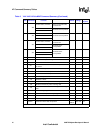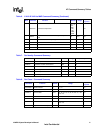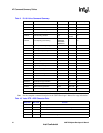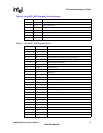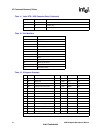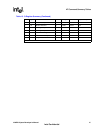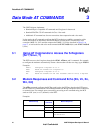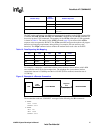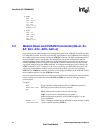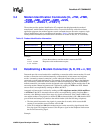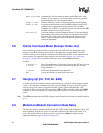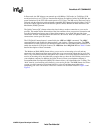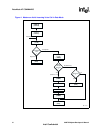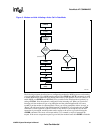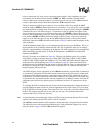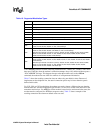
28 536EX Chipset Developer’s Manual
Intel Confidential
Data Mode AT COMMANDS
• ATW3
+MCR: V90
+MRR: 28800
+ER: LAPM
+DR: V42B
+ILRR: 115200
CONNECT 50666
• ATW4
+MCR: V90
+MRR: 28800
+ER: LAPM
+DR: V42B
CONNECT 50666
3.3 Modem Reset and NVRAM Commands [DS=m, Zn,
&F, &Vn, &Yn, &Wn, &Zn=x]
On powering-up, the DCE defaults to the configuration specified in NVRAM. The DCE may then
be configured as needed. The DTE stores the DCE configuration in the NVRAM by first setting up
the current configuration and then sending an AT&Wn command. The DCE configuration stored
in the NVRAM is called a user profile. Two independent user profile configurations and four
telephone numbers can be stored. Either user profile configuration can be used for the power-up
defaults (AT&Yn). While in command mode, the DCE can be re-initialized at any time and the
user profile changed using the ATZn command. To configure the modem to factory defaults, the
AT&F command is used. A summary of the active user profile, two NVRAM user profiles, and
previously-saved telephone numbers can be read from the modem using the view command,
AT&Vn. The AT&Zn=x command stores one of four telephone numbers in the NVRAM. To dial
these telephone numbers, use the ATDS=m command.
If the active profile is not stored in one of the two user profiles after setting up the modem, then the
current settings are lost when the commands ATZ or AT&F are issued or when the modem is
powered down.
Examples:
ATZ Resets and then configures the modem to NVRAM user profile 0.
AT&F S0=1 &W1 &F configures the modem for factory defaults.
&Y1
S0=1 configures the modem to answer after one ring.
&W1 saves the active configuration to user profile 1.
&Y1 configures the modem to use NVRAM user profile 1 as the
power-up defaults.
AT&Z2 = 9, Stores a telephone number into the NVRAM as phone number 2, which
(408)444-5555 can be re-dialed later using ATDS=2.



